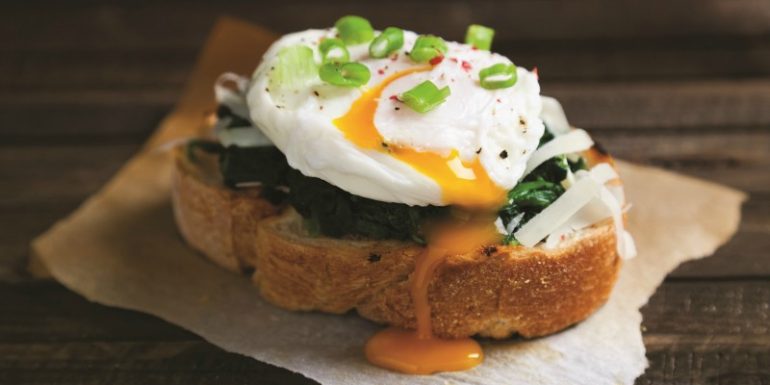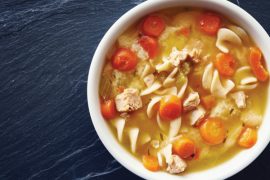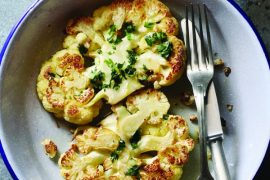By Bill Turner
Sometimes you wonder why it takes so long to get things straight. In 1961, the FDA announced that excess cholesterol in the bloodstream was a health hazard. The scientists and nutritionists then, by extrapolation, said that we had better stop eating things with high levels of cholesterol. The consumption of eggs, which have a large amount of cholesterol, fell by 30 percent in the U.S. Farmers suffered and, health wise, we all suffered for no good reason.
By 2015, the data showed something very interesting. Your body, as you probably know, makes cholesterol. The studies showed that if you reduce the intake of dietary cholesterol, your body increases production. If you increase consumption, the body makes less. The human body seeks a certain level of cholesterol and what you eat has little to do with it. Holy cow, the farmers have been taking it in the ear for 54 years; half of us have been eating egg white omelets, and now they tell us “Oops!” The 2015 FDA Food Guidelines rectified the problem and stated that dietary cholesterol is “not considered a nutrient of concern.”
So, it’s now time to revisit eggs, which are truly a superfood. First, they are a dieter’s friend. Two eggs are a mere 150 calories. Add a piece of buttered toast, a cup of coffee and you have a great breakfast with only 250 calories. Secondly, they have a lot of protein — 7 grams per egg, which is more than most “protein bars” and equal to meat or fish on a calorie for calorie basis. Eggs are also loaded with vitamins and nutrients. They even have a “secret weapon” to help with weight loss: eggs contain Leucine, an amino acid which helps you maintain muscle mass when dieting. Finally, they are inexpensive — anywhere from $0.20 to $0.40 each.
Eggs are also now healthier for you as producers change to higher quality feed to get eggs with a higher level of Omega-3 fats (the good guys) and less Omega-6 fats (the bad guys). If you feed flax seed to chickens, they double the production of Omega-3 fats, so look for the eggs that say Omega-3 on the carton.
EASY WAYS TO ENJOY EGGS
Scrambled eggs:
Go back to the old standard. Skip the bacon, sausage and potatoes.
Whisk the eggs and add the salt and pepper before cooking. Don’t add milk. Melt a little butter in a hot pan, add the eggs. Remove the pan from the heat while the eggs are still wet and let them finish cooking but not get too dry. If you want to be more ambitious, sauté some onion and red pepper and add them to the eggs. Needless to say, this can also lead you into omelets and frittatas.
Eggy Pancake Batter:
You can double or triple the amount of eggs in a pancake recipe and the results are more like crepes, and more nutritious. This is a good way to get the kids to eat more eggs. As long as they get butter and syrup on top, they don’t care.
Breakfast casserole:
Make this the night before when you have a group to feed. It is wonderful and easy and it serves 8-12.
Ingredients:
- 12 eggs
- 8 cups (one large loaf) challah or egg bread, cut into 3/4-inch cubes.
- 1 lb. ham (thickly sliced), diced
- 3 cups whole milk
- 2 cups grated Gruyère cheese (about 8 oz.)
- 3 Tbsp. olive oil
- 3 onions, thinly sliced
- 1 tsp. salt
- ½ tsp. sugar
- 1 tsp. dry mustard
- ½ tsp. freshly grated nutmeg
- 4 tsp. fresh thyme leaves
Directions:
- Grease a large 10″ x 14″ baking dish and add the cubed challah.
- Heat the olive oil in a skillet over medium to low heat. Add the onions, salt, and sugar. Sauté until they are lightly caramelized (a medium golden brown color), about 15 minutes.
- Add the ham and cook about 5 minutes
- Whisk together the eggs, milk, dry mustard, nutmeg, and thyme. Season with salt and pepper.
- Sprinkle onion and ham over the bread cubes. Sprinkle grated Gruyère on top, and then pour the egg mixture over the entire thing.
- Press down on the top gently with a spatula, so that all the bread cubes get soaked with the egg mixture. Cover and refrigerate overnight.
- In the morning, preheat the oven to 350 degrees F. Take the casserole out of the fridge while the oven is preheating. Bake, uncovered, for 30-35 minutes, or until the edges are bubbling and the top begins to brown.
If you are hosting brunch, serve with a green salad, some asparagus, and a tall V-8 or Bloody Mary. Cut the recipe in half for a smaller group and use an 8″ x 8″ pan.
DEVILED EGGS: THE GO-TO APPETIZER
You’ll never go wrong with deviled eggs for cocktail hour or for a party where you want to show off your culinary skills. There are endless variations. To start, boil six eggs for 10 minutes, cool in cold water, peel under running water and cut in half lengthwise. Carefully extract the yolks and mash together in a mixing bowl with two tablespoons of olive oil. You are now ready to get creative.
You can basically add anything you like to the mixture. Here is one of my favorites from the great Marcella Hazan:
Green Eggs:
Start with the yolks and olive oil as described above and add the following ingredients:
Ingredients:
- ½ Tbsp. capers – drained and washed
- 1 Tbsp. chopped parsley
- 3 anchovy filets – washed and finely chopped
- ½ tsp. garlic – finely chopped
- ¼ tsp. Dijon mustard
- 1 pinch of salt
- 2 Tbsp. red pepper – finely chopped
Directions:
- Mix all the ingredients except the red pepper and spoon back into the whites.
- Garnish with the red pepper.
Avocado Eggs:
Add the following to the yolks and olive oil:
Ingredients:
- 1 ripe avocado – diced
- 2 Tbsp. lime juice
- 1 Tbsp. jalapeño pepper – seeded and finely diced
- 3 Tbsp. fresh cilantro – finely chopped
- 2 Tbsp. red pepper – finely chopped
Directions:
Mix all the ingredients except the red pepper and spoon back into the whites. Garnish with the red pepper.
Dollop Eggs:
Add these ingredients to the yolk and olive oil mixture.
Ingredients:
- Pinch of salt
- ½ tsp. finely chopped garlic
Directions:
Mix well and spoon back into the whites. Now you can simply add a dollop of some exotic ingredient and serve. Some of my favorites are chutney, caviar, bacon bits or mint jelly. Let yourself go wild!
Good vs. Bad Fats: What You Need to Know
The human body cannot make two types of Essential Fatty Acids or EFAs, which are called, in shorthand, Omega-3 and Omega-6. These EFAs are needed by the body to produce a host of enzymes and proteins. We would die without these fats. Good levels of Omega 3 fats have been shown to help regulate blood pressure, lower cholesterol, improve mood and brain function and even boost immunity, to mention a few of its health benefits. However, modern diets are generally deficient in Omega-3 fats and contain an excess of Omega-6 fats. The excess of Omega-6 fats is associated with a host of health problems including arthritis, inflammation, and cancer. Generally, we should be increasing Omega-3 fats in our diet and decreasing Omega-6 fats. Good sources of Omega-3 are eggs, fish oil, salmon, grass-fed beef, sardines and walnuts.





